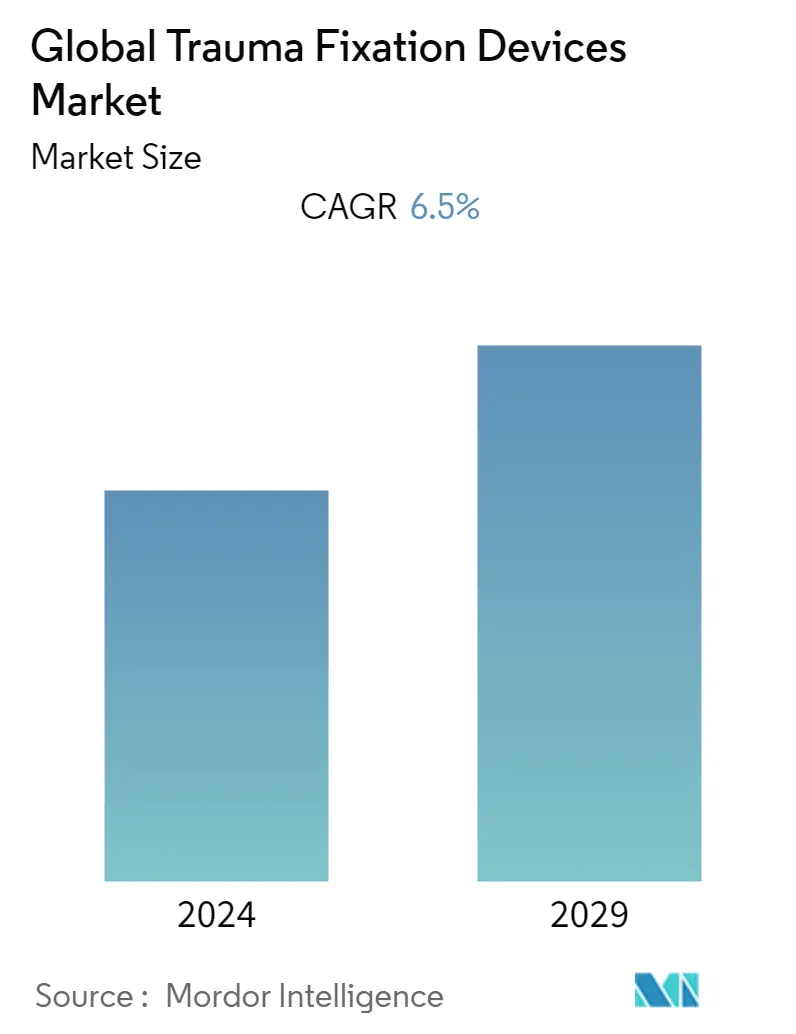Market Size of Global Trauma Fixation Devices Industry

| Study Period | 2019 - 2029 |
| Base Year For Estimation | 2023 |
| Forecast Data Period | 2024 - 2029 |
| CAGR | 6.50 % |
| Fastest Growing Market | Asia Pacific |
| Largest Market | North America |
Major Players
*Disclaimer: Major Players sorted in no particular order |
Trauma Fixation Devices Market Analysis
The trauma fixation devices market is expected to register a CAGR of nearly 6.5% during the forecast period.
Due to the outbreak of COVID-19, the overall trauma fixation devices market experienced a significant impact in terms of demand. As per the study titled, ''Fracture management during COVID-19 pandemic: A systematic review'', published in July 2020, the COVID-19 has drastically reduced the burden of fracture patients worldwide. Thus, a negative impact is expected on the market studied due to the outbreak of COVID-19.
The trauma fixation devices market is expected to be primarily driven by increasing demand for trauma fixation devices in hospital departments and outpatient surgery. According to the World Health Organization, 2020, more than 1.35 million people die every year due to road traffic crashes and accidents. Road traffic injuries are one of the leading causes of mortality, especially among people aged between 15 and 29 years.
Furthermore, as per the Organization for Economic Co-operation and Development data, in 2019, about 51.9 per 100,000 individuals met with road traffic accidents in Canada, while around 52.6 per 100,000 individuals met with road traffic accidents in Italy. Hence, these above-stated statistics show that the increasing number of road injuries and accidents is affecting the global population, which is ultimately increasing the demand for trauma fixation devices in healthcare facilities.
Additionally, the demand for trauma fixation devices is also growing due to technologically advanced products, such as bioresorbable implants and nano-coated devices. In June 2020, Depuy Synthes, a subsidiary of Johnson & Johnson, launched Dynacord Suture in several European markets. The product is intended to be used in procedures, such as soft tissue approximation, in rotator cuff repairs.
Some of the other factors contributing to the market growth are the rising geriatric population, the growing burden of degenerative bone diseases, and increasing incidences of sports injuries, worldwide.
Trauma Fixation Devices Industry Segmentation
As per the scope of the report, trauma is a physical injury that includes burns, fractures, sprains, strains, etc., caused by any external source (fire and accident). The Centers for Disease Control and Prevention (CDC) has defined trauma as 'an injury or wound to a living body caused by the application of external force or violence'. The trauma fixation devices market is segmented by type (internal (plates, screws, nails, and others) and external fixators (unilateral and bilateral external fixators, circular fixators, and hybrid fixators), surgical site (lower extremities (hip and pelvic, foot and ankle, knee, and others) and upper extremities (hand and wrist, shoulder, spine, and others), end user (hospitals, ambulatory surgery centers, and other end users), and geography (North America, Europe, Asia-Pacific, Middle East and Africa, and South America). The report offers the value (in USD million) for the above segments.
| By Type | ||||||
| ||||||
|
| By Surgical Site | ||||||
| ||||||
|
| By End User | |
| Hospitals | |
| Ambulatory Surgery Centers | |
| Other End Users |
| By Geography | ||||||||
| ||||||||
| ||||||||
| ||||||||
| ||||||||
|
Global Trauma Fixation Devices Market Size Summary
The trauma fixation devices market is poised for growth, driven by increasing demand in hospital departments and outpatient surgery settings. The market's expansion is influenced by the rising incidence of road traffic accidents, which are a leading cause of injuries, particularly among younger populations. Technological advancements, such as bioresorbable implants and nano-coated devices, are further propelling market growth. The market is also supported by the aging population, the prevalence of degenerative bone diseases, and the rising occurrences of sports injuries. Despite the initial negative impact of COVID-19 on demand due to reduced fracture cases and delayed surgeries, the market is expected to recover and grow as healthcare activities resume.
The circular fixator segment is anticipated to maintain a significant share in the market, with innovations like the Ilizarov external fixator and Taylor Spatial Frame enhancing treatment options for periprosthetic fractures. The introduction of new products by key players, such as AMDT Holdings Inc. and DePuy Synthes, is expected to strengthen market presence and drive growth. North America is projected to experience increased demand, supported by a growing geriatric population and the rising burden of osteoporosis. However, challenges such as decreasing Medicare reimbursements for orthopedic trauma surgery may hinder market expansion. The market remains moderately fragmented, with major players including Medtronic PLC, Stryker Corporation, and Johnson & Johnson, among others, actively contributing to its development.
Global Trauma Fixation Devices Market Size - Table of Contents
-
1. MARKET DYNAMICS
-
1.1 Market Overview
-
1.2 Market Drivers
-
1.2.1 Growing Burden of Bone Degenerative Diseases
-
1.2.2 Increasing Number of Road Accidents
-
1.2.3 Technological Advancements in Medical Devices
-
-
1.3 Market Restraints
-
1.3.1 Lack of Trained Professionals
-
1.3.2 Stringent Regulatory Issues
-
-
1.4 Industry Attractiveness - Porter's Five Forces Analysis
-
1.4.1 Bargaining Power of Buyers/Consumers
-
1.4.2 Bargaining Power of Suppliers
-
1.4.3 Threat of New Entrants
-
1.4.4 Threat of Substitute Products
-
1.4.5 Intensity of Competitive Rivalry
-
-
-
2. MARKET SEGMENTATION
-
2.1 By Type
-
2.1.1 Internal Fixators
-
2.1.1.1 Plates
-
2.1.1.2 Screws
-
2.1.1.3 Nails
-
2.1.1.4 Others
-
-
2.1.2 External Fixators
-
2.1.2.1 Unilateral and Bilateral External Fixators
-
2.1.2.2 Circular Fixators
-
2.1.2.3 Hybrid Fixators
-
-
-
2.2 By Surgical Site
-
2.2.1 Lower Extremities
-
2.2.1.1 Hip and Pelvic
-
2.2.1.2 Foot and Ankle
-
2.2.1.3 Knee
-
2.2.1.4 Others
-
-
2.2.2 Upper Extremities
-
2.2.2.1 Hand and Wrist
-
2.2.2.2 Shoulder
-
2.2.2.3 Spine
-
2.2.2.4 Others
-
-
-
2.3 By End User
-
2.3.1 Hospitals
-
2.3.2 Ambulatory Surgery Centers
-
2.3.3 Other End Users
-
-
2.4 By Geography
-
2.4.1 North America
-
2.4.1.1 United States
-
2.4.1.2 Canada
-
2.4.1.3 Mexico
-
-
2.4.2 Europe
-
2.4.2.1 Germany
-
2.4.2.2 United Kingdom
-
2.4.2.3 France
-
2.4.2.4 Italy
-
2.4.2.5 Spain
-
2.4.2.6 Rest of Europe
-
-
2.4.3 Asia Pacific
-
2.4.3.1 China
-
2.4.3.2 Japan
-
2.4.3.3 India
-
2.4.3.4 Australia
-
2.4.3.5 South Korea
-
2.4.3.6 Rest of Asia Pacific
-
-
2.4.4 Middle-East and Africa
-
2.4.4.1 GCC
-
2.4.4.2 South Africa
-
2.4.4.3 Rest of Middle-East and Africa
-
-
2.4.5 South America
-
2.4.5.1 Brazil
-
2.4.5.2 Argentina
-
2.4.5.3 Rest of South America
-
-
-
Global Trauma Fixation Devices Market Size FAQs
What is the current Global Trauma Fixation Devices Market size?
The Global Trauma Fixation Devices Market is projected to register a CAGR of 6.5% during the forecast period (2024-2029)
Who are the key players in Global Trauma Fixation Devices Market?
Medtronic PLC, Stryker Corporation, Johnson & Johnson, Cardinal Health Inc. and Smith & Nephew PLC are the major companies operating in the Global Trauma Fixation Devices Market.

